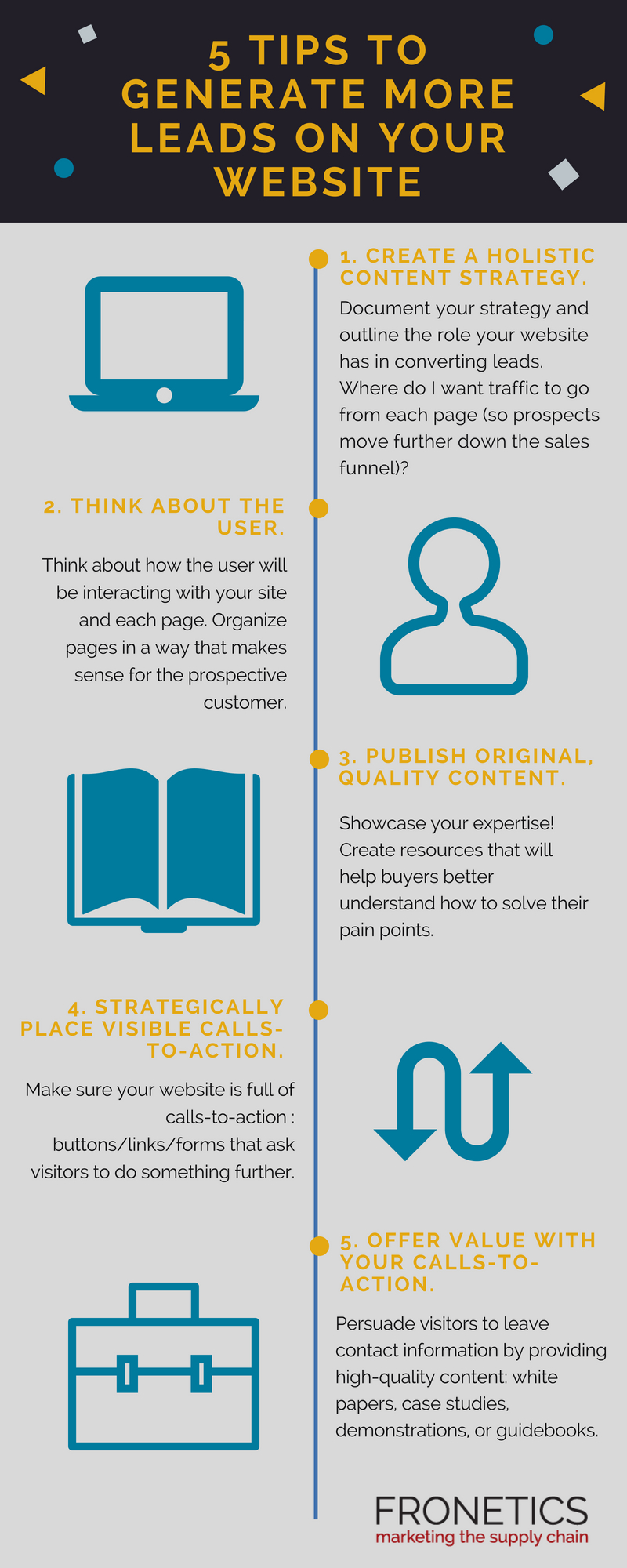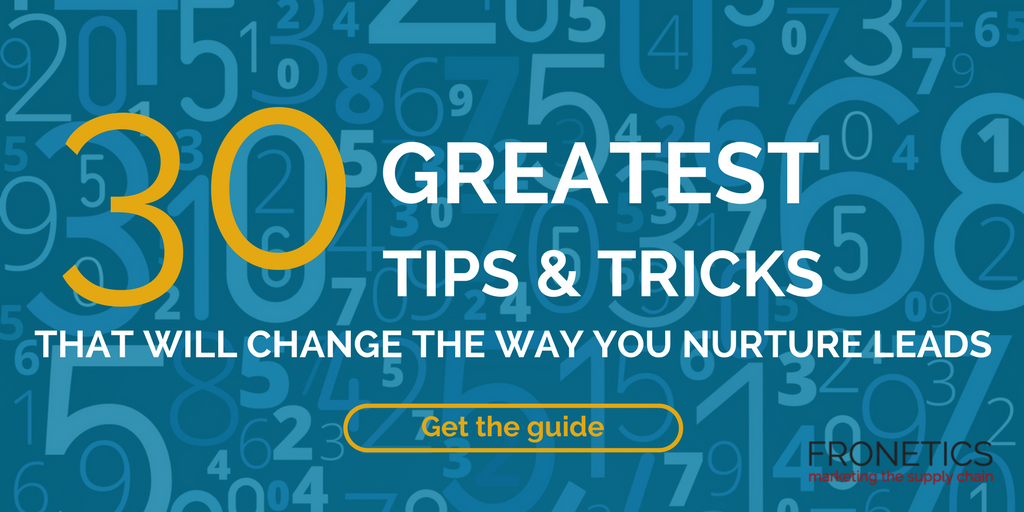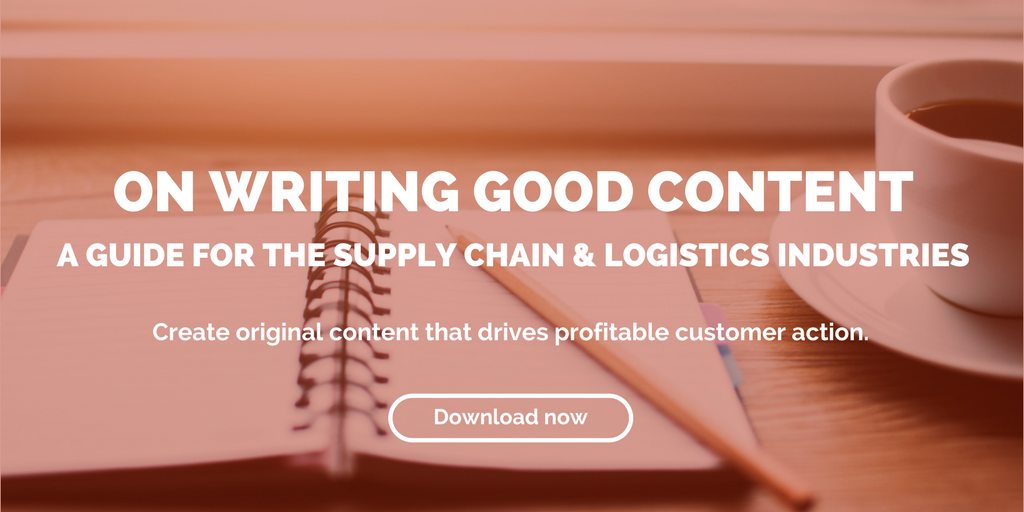
by Fronetics | Jun 21, 2018 | Blog, Content Marketing, Logistics, Marketing, Supply Chain
If you’re looking to generate more leads on your website, you need to create opportunities to capture visitors and implement a strong content strategy to encourage engagement.
Lots of supply chain and logistics companies are catching on to the benefits of content marketing. And of those, many are implementing a content marketing strategy to plan and execute their marketing.
[bctt tweet=”There’s no point in pouring a bunch of time, money, and resources into a robust content marketing program if the website that you’re driving traffic to stinks.” username=”Fronetics”]
But there’s an issue a lot of supply chain and logistics companies are running into: a weak website that doesn’t encourage the generation of leads. Essentially, there’s no point in pouring a bunch of time, money, and resources into a robust content marketing program if the website that you’re driving traffic to stinks.
In a recent post, we talk about what a weak website looks like. If you think you may fall into this category, don’t fret. There is still time to generate more leads on your website.
Consistently producing quality content and making sure you’re utilizing various distribution channels — social media, a blog, etc. — will help draw your target audience to your website. Once they’re on your site, you need to make sure they have a positive user experience. And more importantly, they need ample opportunities to learn more about your products and services.
These opportunities to engage with your content help move users down the sales funnel. You’ll capture leads that have the potential to become sales.
So how do you ensure your website is a lead-generating machine? Here are five tips to generate more leads on your website.
Infographic: 5 tips to generate more leads on your website

(Made with Canva)
Most importantly, remember to be prudent about the role your website plays in the lead-generation process. A strong website with quality content, great visuals, and easily identifiable calls-to-action only works to generate leads and push users down the sales funnel. You’ll still need someone to help close the deal.
Related posts:


by Fronetics | May 23, 2018 | Blog, Content Marketing, Logistics, Marketing, Strategy, Supply Chain
If you’re hoping to generate more leads on your website, you’re going to have to develop a holistic content strategy and create many strong calls-to-action.
You may have read part one of this mini-series about the importance of having a solid website if you’re going to invest in content marketing. Essentially, there’s no point in pouring a bunch of time, money, and resources into a robust content marketing program if the website that you’re driving traffic to stinks.
Be thoughtful about the role your website plays in the lead-generation process. It’s a really important piece of the puzzle that companies often overlook.
Consistently producing quality content and distributing it through various channels, like social media, will help attract your target audience to your website. But unless you provide them with a good user experience while they’re there — and give them plenty of opportunity to opt in to learn more about your business — you’re not going to move them down the sales funnel. And you’re not going to generate more leads on your website.
So how do you ensure your website is a lead-generating machine? Here’s what I know.
5 tips to generate more leads on your website
1) Create a holistic content strategy.
I can’t overstate the importance of creating a content marketing strategy, documenting it, and then designating someone to lead it if you want your content marketing to be successful. As part of that strategy, you should outline the role your website will play in assisting the conversion of leads.
Ask yourself these questions:
- Do different pages of my website suit prospects at different stages of the buyer’s journey?
- Where do I want traffic to go from each page (so prospects move further down the funnel)?
- What calls-to-action can I add to each page to assist them in that move?
- Which pages are ripe for lead conversion, and which are better for providing information?
- If you’re using the topic cluster model (which you should be!), where are my pillar pages and corresponding topic cluster pages?
Also, make sure your messaging is consistent across your website and your regularly published content (like blog posts).
2) Think about the user and how s/he experiences your site.
Hopefully in creating a holistic content strategy that includes your website, you’re thinking primarily about how the user will be interacting with your site and each page. That means organizing pages in a way that makes sense for the prospective customer, rather than internal politics.
That sounds easy, but I have helped many organizations for whom this is incredibly challenging. Often, one department (or person) feels strongly that something very important to them deserves real estate on the homepage or in the main navigation. But, if it’s not something that is meaningful to a prospective customer, you’d best not cave. Doing some usability testing with prospects is a good way to collect data to support your reasoning.
Also to consider: think about the language your buyers are comfortable with, and avoid any overly jargony or technical wording. Make sure to lay things out in a way that is approachable for them. And aim to provide the information they seek, rather than trying to sell them at every step.
3) Publish original, quality content.
Along those same lines, the best way to convince today’s B2B buyer to choose you as a vendor is to win them over with your content. Content marketing is all about positioning yourself as an expert in the industry, after all, the business that knows the most about your product/service.
Instead of promoting your business on every page, use each as an opportunity to showcase your expertise. Create resources that will help buyers better understand how to solve their pain points. And make sure everything you publish is well-written, offers value to prospects, and is completely original. You want people to want to read what you have to say.
Consider incorporating various content formats to cater to different learning preferences:
- In-depth blog posts and articles
- Infographics for visual learners
- Short video tutorials or explainers
- Podcasts for those who prefer audio content
4) Strategically place strong, visible calls-to-action.
I’ve hinted at this one already, but it bears further explanation. Make sure your website is full of calls-to-action, or buttons/links/forms that ask visitors to do something further. After all, how do you expect someone to take an action (like providing their email address) if you don’t ask them to do it?
You can generate more leads on your website by asking visitors to become leads more often.
Make sure these calls-to-action stand out on the page so that visitors’ eyes naturally go there. Be very clear about what you’re asking for and/or what the user will get in return when they complete the action. And, again, be strategic about what you’re asking people to do on which page. You won’t have much luck, for example, asking visitors to call a sales rep on a page that is designed to assist them with initial information-gathering.
Pro tip: Use A/B testing to optimize your CTAs. Try different colors, copy, and placements to see what resonates best with your audience.
5) Offer value with your calls-to-action.
Sometimes it might take a little convincing to get visitors to provide their contact information. The best way to persuade them? Give them something they want in exchange.
We call this high-value content. Examples might include:
- Case studies
- White papers/industry reports
- Webinars
- Tutorials or how-tos
- Demonstrations
- Sneak peaks or previews
- Guides or ebooks
- Podcasts
Ask visitors to download your high-value content by completing a form, which asks for their email address. Set up your marketing automation to email the content to them, then send a series of lead-nurturing emails following up at strategic intervals to keep them moving down the sales funnel.
If you want to generate more leads on your website, follow these five steps. Above all, just be thoughtful about the role your website plays in the lead-generation process. It’s a really important piece of the puzzle that companies often overlook.
Related posts:


by Fronetics | May 22, 2018 | Blog, Content Marketing, Logistics, Marketing, Supply Chain
If you don’t give visitors many easy, attractive opportunities to convert on your website, content marketing won’t generate leads for you.
I’ve been noticing a trend lately that I wanted to share.
We talk with a lot of supply chain and logistics companies who are interested in the idea of content marketing. They’re catching on to the benefits, particular those involving lead generation. They know that creating high-quality, original content on a regular basis — mostly, timely blog posts on a weekly (or more frequent) basis — can drive organic traffic to their websites. And a lot of that traffic will be marketing- or sales-qualified leads.
[bctt tweet=”Content marketing won’t generate leads if you’re driving visitors to a website that stinks.” username=”Fronetics”]
That’s great! I’m glad supply chain and logistics companies are increasingly interested in content marketing. But there’s one problem: Some aren’t willing to take a holistic approach to this solution. Mostly, they aren’t willing to improve their websites.
I totally get it: Websites are a major investment — both financially and temporally. But so is content marketing. And you would be wasting a lot of time and money investing in a content marketing program if all the leads you’re going to drive to your website don’t convert or end up with mixed messaging about your business.
When content marketing won’t generate leads
Content marketing won’t generate leads if you’re driving visitors to a website that stinks. How do you know if your website stinks? Here are a few examples:
Your content is disorganized, unclear, or filled with jargon.
I see this most often. Companies create websites without considering a larger content strategy. Their company or products/services have evolved over time, but the website has not evolved with it (or someone quickly threw up a couple of extra pages without considering the site map as a whole). And, worst of all, web pages become filled with jargon and corporate speak because companies don’t take the time to strategize web page creation as part of that larger content strategy.
Messaging on your website pages serves internal purposes rather than helping customers.
So many businesses create their websites and fill pages with information about their company. “Wait, isn’t that what a website is for?” you might be asking.
No, I would argue. Your website, like your content, should service the customer first. You should design it with the user in mind, helping that prospect find the information they’re seeking and move seamlessly down the sales funnel.
Sure, you should include information about your company on your website. But too many times I see organizations forget about their customers in the creation of their sites. And when prospects visit, they’re caught in a web of the company’s self-promotion — an no closer to making a purchase than before.
There are no opportunities for conversion.
This one seems obvious. But, for some reason, companies frequently create websites hoping to generate leads but give visitors few (or hidden!) opportunities for conversion. If each page doesn’t have a clear call-to-action, specific to the page’s content, with the opportunity to submit contact information, how do you suppose visitors are going to become leads? I’ll say from experience, very few, if any, will proactively reach out and ask to join your email list.
Get it together
If you’re going to make the significant investment in content marketing — and lead generation is your primary goal — you have to think about your website, too. Otherwise, the traffic you’re driving to your site will never convert. And you’ll have wasted your time and money.
Want to make your website an effective lead-generating machine? Stay tuned for part 2 of this post tomorrow: 5 Tips to Generate More Leads on Your Website.
Related posts:


by Fronetics | Jan 18, 2018 | Blog, Content Marketing, Marketing
With a high correlation between publishing frequency and web traffic and leads, you need to publish blog content more often to boost lead generation efforts. Here are Fronetics, most of our clients are sales-driven. If a client’s business goals include earning leads,...

by Fronetics | Oct 30, 2017 | Blog, Content Marketing, Marketing, Strategy
Relationships take time and trust to fully develop, and lead nurturing is no different.
Before I got married in 2009, I spent most of my twenties in the dating pool. I would meet someone. We would exchange phone numbers. And through a series of texts and calls, we would eventually meet for dinner. One dinner would lead to another and possibly another.
Lead nurturing isn’t all that different. When you first meet your lead, chances are they won’t be ready to purchase right away. In fact, 63% of consumers requesting info on your company today will not purchase for at least 3 months. But if you spend time establishing a relationship and building trust, the moment your lead is ready to purchase, you’ll be miles ahead of your competition.
As more and more buyers are engaging with brands before they are ready to purchase, an essential function of any marketing department is lead nurturing. That is, moving leads through the sales funnel by leveraging what you know about their needs and online behavior. Marketing software company Marketo describes lead nurturing as being “personalized, adaptive, and able to listen and react to buyer behavior in real time.”
Lead nurturing, like dating, takes time to establish a relationship and move toward the ultimate goal of converting from lead to customer. Here are five tips to help nurture these relationships.
5 lead nurturing tips
1. Make a good first impression
You would never go on a date without looking and feeling your best. The same should be true for your website, your company’s online home. As part of your preparation for a lead nurturing campaign, review your website and make any necessary modifications so that it presents the best digital representation of your business. Beyond increasing conversions, having an attractive, modern website that’s free of broken links and out-of-date contact information establishes your company as a trusted resource for information.
2. Make a plan ahead of time
Where are you going to dinner? Are you making a reservation? What are you doing after dinner? Preparing for a date requires some thought and planning, especially when considering your date’s preferences. Content selection requires the same forethought. The decision about what content you’ll offer your leads will be guided by the preferences and needs of your prospects. Create content that is relevant to your leads, and make sure to identify appropriate channels of distribution in order to extract maximum value from your content.
3. It takes time
Dating tends to happen in stages that occur over weeks and months. Similarly, the lead nurturing process is intended to push content to leads in a linear fashion, with the ultimate goal being that they’ll emerge as customers. Once you’ve moved past the first date, so to speak, you’ll want to decide how to continue romancing your leads. To do that, align content with where your leads happen to be in the buyer’s journey. Leads will enter and exit your lead nurturing campaign at different points, and that’s okay. Just be certain that your content is relevant to leads in their specific stage. Regardless, each nurturing touch should be focused and specific and include a call-to-action to promote advancement in the buyer’s journey.
4. Communication is key
As with any relationship, the foundation of lead nurturing is communication. Being able to hold meaningful conversations builds a genuine interest and helps improve any relationship. In other words, don’t view the lead nurturing process as a way to blast your prospects with promotional information or marketing materials; treat it as a dialogue. The best lead nurturing campaigns are designed to help you learn as much about your leads as you would have them learn about your company.
5. Show your interest and appreciation
We all want to feel appreciated, and the same is true for your customers and leads. Whether it’s by showing gratitude to current customers for their continued support or showing appreciation to leads for their download, saying thank you goes a long way in building connections and professional relationships.
In our personal and professional lives, we want relationships built on trust over time. A successful lead nurturing campaign is constructed on these same principals. When you plan ahead, don’t rush the process and create opportunities for meaningful communication, the possibilities are endless.
Want to learn more about lead nurturing? Check out these 30 tricks and tips that will change the way you nurture leads.
Related posts:










